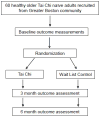A systems biology approach to studying Tai Chi, physiological complexity and healthy aging: design and rationale of a pragmatic randomized controlled trial
- PMID: 23026349
- PMCID: PMC3638751
- DOI: 10.1016/j.cct.2012.09.006
A systems biology approach to studying Tai Chi, physiological complexity and healthy aging: design and rationale of a pragmatic randomized controlled trial
Abstract
Introduction: Aging is typically associated with progressive multi-system impairment that leads to decreased physical and cognitive function and reduced adaptability to stress. Due to its capacity to characterize complex dynamics within and between physiological systems, the emerging field of complex systems biology and its array of quantitative tools show great promise for improving our understanding of aging, monitoring senescence, and providing biomarkers for evaluating novel interventions, including promising mind-body exercises, that treat age-related disease and promote healthy aging.
Material and methods: An ongoing, two-arm randomized clinical trial is evaluating the potential of Tai Chi mind-body exercise to attenuate age-related loss of complexity. A total of 60 Tai Chi-naïve healthy older adults (aged 50-79) are being randomized to either six months of Tai Chi training (n=30), or to a waitlist control receiving unaltered usual medical care (n=30). Our primary outcomes are complexity-based measures of heart rate, standing postural sway and gait stride interval dynamics assessed at 3 and 6months. Multiscale entropy and detrended fluctuation analysis are used as entropy- and fractal-based measures of complexity, respectively. Secondary outcomes include measures of physical and psychological function and tests of physiological adaptability also assessed at 3 and 6months.
Discussion: Results of this study may lead to novel biomarkers that help us monitor and understand the physiological processes of aging and explore the potential benefits of Tai Chi and related mind-body exercises for healthy aging.
Copyright © 2012 Elsevier Inc. All rights reserved.
Figures


References
-
- Lipsitz LA, Goldberger AL. Loss of ‘complexity’ and aging. Potential applications of fractals and chaos theory to senescence. Jama. 1992;267(13):1806–9. - PubMed
-
- Lipsitz LA. Aging as a Process of Complexity Loss. In: Deisboeck TSKJ, editor. Complex Systems Science in Biomedicine. Springer; 2006. pp. 641–54.
-
- Goldberger AL. Non-linear dynamics for clinicians: chaos theory, fractals, and complexity at the bedside. Lancet. 1996;347(9011):1312–4. - PubMed
-
- Taylor-Piliae RE. Tai Chi as an adjunct to cardiac rehabilitation exercise training. J Cardiopulm Rehabil. 2003;23(2):90–6. - PubMed
Publication types
MeSH terms
Grants and funding
LinkOut - more resources
Full Text Sources
Other Literature Sources
Medical

